Class 10 - Mathematics
Areas Related To Circles - Exercise 12.2

Top Block 1
Exercise 12.2
Question : 1:Find the area of a sector of a circle with radius 6 cm if angle of the sector is 60°.
Answer :

Angle of the sector (θ) = 60°
Now, area of sector = (θ/360°) * πr2
= (60°/360°) * (22/7) * 62
= (1/6) * (22/7) * 6 * 6
= (22/7) * 6
= 132/7 cm2
Question : 2:Find the area of a quadrant of a circle whose circumference is 22 cm.
Answer :
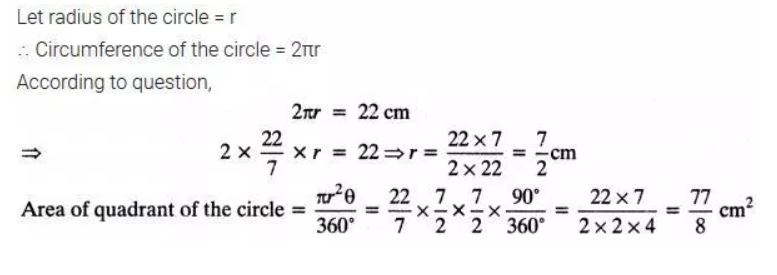
Mddle block 1
Given, circumference of the circle = 22
⇒ 2πr = 22
⇒ 2 * (22/7) * r = 22
⇒ 2r/7 = 1
⇒ r = 7/2 cm
So, area of the quadrant (1/4)th of the circle = (θ/360) * πr2
= (90°/360°) * (22/7) * (7/2)2
= (1/4) * (22/7) * (7/2) * (7/2)
= (1/4) * 11 * (7/2)
= 77/8 cm2
Question : 3:The length of the minute hand of a clock is 14 cm. Find the area swept by the minute hand in 5 minutes.
Answer :
Length of minute hand = radius of the circle
⇒ r = 14 cm
Angle swept by the minute hand in 60 minutes = 360°
Angle swept by the minute hand in 5 minutes = (360°/60) * 5 = 6 * 5 = 30°
Now, area of the sector with r = 14 and θ = 30° is given as
= (θ/360°) * πr2
= (30°/360°) * (22/7) * 142
= (1/12) * (22/7) * 14 * 14
= (11 * 14)/3
= 154/3 cm2
Thus, the required area swept by the minute hand by 5 minutes = 154/3 cm2
Question : 4:A chord of a circle of radius 10 cm subtends a right angle at the centre.
Find the area of the corresponding: (i) minor segment (ii) major sector. (Use π = 3.14)
Answer :
Length of the radius (r) = 10 cm
Sector angle θ = 90°
Area of the sector with θ = 90° and r = 10 cm is given as
= (θ/360°) * πr2
= (90°/360°) * 3.14 * 102
= (1/4) * 3.14 * 10 * 10
= 3.14 * 5 * 5
= 78.5 cm2
(i) Area of the minor segment = Area of minor sector – Area of ΔAOB
= 78.5 – (1/2) * 10 * 10
= 78.5 – 50
= 28.5 cm2
(ii) Area of major segment = Area of the circle] – Area of the minor segment
= πr2 – 78.5
= 3.14 * 10 * 10 – 78.5
= 314 – 78.5
= 235.5 cm2
Question : 5:In a circle of radius 21 cm, an arc subtends an angle of 60° at the centre. Find:
(i) the length of the arc (ii) area of the sector formed by the arc
(iii) area of the segment formed by the corresponding chord
Answer :

(i) Circumference of the circle = 2πr
= 2 * (22/7) * 21
= 2 * 22 * 3
= 132 cm
Now, length of the arc APB = (60°/360°) * 132
= 132/6
= 22 cm
(ii) Area of the sector with angle 60° = (θ/360°) * πr2
= (60°/360°) * (22/7) * 212
= (1/6) * (22/7) * 21 * 21
= 11 * 21
= 231 cm2
(iii) Area of the segment APQ = Area of the sector AOB – Area of ΔAOB ………….1
In ΔAOB, OA = OB = 21 cm
So, ∠A = ∠B = 60° [∠O = 60°]
⇒ AOB is an equilateral triangle,
Hence, AB = 21 cm
Draw OM ⊥ AB such that OM/OA = sin 60°
⇒ OM/OA = √3/2
⇒ OM = (√3/2) * 21
Now, area of triangle OAB = (1/2) * AB * OM
= (1/2) * 21 * (√3/2) * 21
= 441√3/4 cm2 ………….2
From equation 1 and 2, we get
Area of segment = (231 – 441√3/4) cm2
Question : 6:A chord of a circle of radius 15 cm subtends an angle of 60° at the centre.
Find the areas of the corresponding minor and major segments of the circle. (Use π = 3.14 and √3 = 1.73)
Answer :

Sector angle θ = 60°
Area of the sector with angle 60° = (θ/360°) * πr2
= (60°/360°) * 3.14 * 152
= (1/6) * 3.14 * 15 * 15
= 1.57 * 5 * 15
= 117.75 cm2
Since∠O = 60° and OA = OB = 15 cm
∠AOB is an equilateral triangle.
⇒ AB = 15 cm and ∠A = 60°
Draw OM Ʇ AB
So, OM/OA = sin 60° = √3/2
⇒ OM = OA * √3/2
⇒ OM = 15 * √3/2
Now, ar(ΔAOB) = 1/2 * AB * OM
= 1/2 * 15 * 15 * √3/2
= 225√3/4
= (225 * 3.14)/4
= 20.4375 cm2
Now area of the minor segment = (Area of minor sector) – (ar ΔAOB)
= (117.75 – 97.3125) cm2
= 20.4375 cm2
Area of the major segment = Area of the circle – Area of the minor segment
= πr2 – 20.4375
= 3.14 * 15 * 15 – 20.4375
= 706.5 – 20.4375 cm
= 686.0625 cm2
Question : 7:A chord of a circle of radius 12 cm subtends an angle of 120° at the centre.
Find the area of the corresponding segment of the circle. (Use π = 3.14 and √3 = 1.73)
Answer :
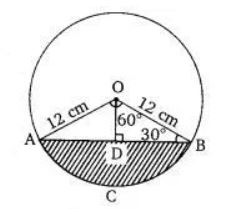
Area of the sector = (θ/360°) * πr2
= (120°/360°) * 3.14 * 122
= (1/3) * 3.14 * 12 * 12
= 3.14 * 12 * 4
= 150.72 cm2 …………..1
Now, area of ΔAOB = 1/2 * AB * OM ………..2
In ΔOAB, ∠O = 120°
⇒ ∠A + ∠B = 180°– 120°
⇒ ∠A + ∠B = 60°
Since, OB = OA = 12 cm
So, ∠A = ∠B = 30°
Again, OM/OA = sin 30° = 1/2
⇒ OM = OA * 1/2
⇒ OM = 12/2 = 6 cm
In right angle triangle AMO,
AM2 = 122 – 62
⇒ AM2 = 144 – 36
⇒ AM2 = 108
⇒ AM = √108
⇒ AM = 6√3
⇒ 2AM = 6√3
⇒ AM = 12√3
From equation 2, we get
Area of ΔAOB = 1/2 * AB * OM
= 1/2 * 12√3 * 6
= 36√3
= 36 * 1.73
= 62.28 cm2 ……….3
From equation 1 and 3, we get
Area of the minor segment = Area of minor segment – Area of ΔAOB
= 150.72 – 62.28 cm
= 88.44 cm2
Question : 8:A horse is tied to a peg at one corner of a square shaped
grass field of side 15 m by means of a 5 m long rope (see Fig. 12.11).
Find:
(i) the area of that part of the field in which the horse can graze.
(ii) the increase in the grazing area if the rope were 10 m long instead of 5 m. (Use π = 3.14)

Answer :
Here, Length of the rope = 5 m
Radius of the circular region grazed by the horse = 5 m
(i) Area of the circular portion grazed = (θ/360°) * πr2
= (90°/360°) * 3.14 * 52
= (1/4) * 3.14 * 5 * 5
= 78.5/4
= 19.625 m2
(ii) When length of the rope is increased to 10 m,
So, r = 10 m
Area of the circular region where θ = 90°.
= (θ/360°) * πr2
= (90°/360°) * 3.14 * 102
= (1/4) * 3.14 * 10 * 10
= 314/4 = 78.5 m2
So, increase in the grazing area = 78.5 – 19.625 = 58.875 m2
Question : 9:A brooch is made with silver wire in the form of a circle with diameter 35 mm. The wire is also used in making 5 diameters
which divide the circle into 10 equal sectors as shown in Fig. 12.12.
Find:
(i) the total length of the silver wire required.
(ii) the area of each sector of the brooch.
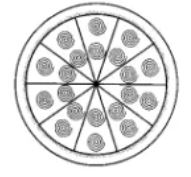
Answer :
Diameter of the circle = 35 mm
Radius (r) = 35/2 mm
(i) Circumference = 2πr
= 2 * (22/7) * (35/2)
= 22 * 5
= 110 mm
Length of 1 piece of wire used to make diameter to divide the circle into 10 equal sectors
= 35 mm
So, length of 5 pieces = 5 * 35 = 175 mm
Hence, total length of the silver wire = 110 + 175 mm = 285 mm
(ii) Since the circle is divided into 10 equal sectors,
Hence, Sector angle θ = 360°/10 = 36°
Now, area of each sector = (θ/360°) * πr2
= (36°/360°) * (22/7) * (35/2) * (35/2)
= (11 * 35)/4
= 385/4 mm2
Question : 10:An umbrella has 8 ribs which are equally spaced (see Fig. 12.13). Assuming umbrella to be a flat circle
of radius 45 cm, find the area between the two consecutive ribs of the umbrella.
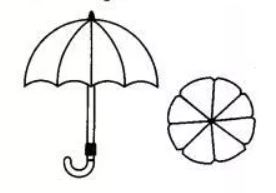
Answer :
Here, radius (r) = 45 cm
Since circle is divided in 8 equal parts,
Now, sector angle corresponding to each part θ = 360°/8 = 45°
Now, area of a sector(part) = (θ/360°) * πr2
= (45°/360°) * (22/7) * 45 * 45
= (1/8) * (22/7) * 45 * 45
= (1/4) * (11/7) * 45 * 45
= (11 * 45 * 45)/(4 * 7)
= 22275/28 mm2
Hence, the required area between two pins = 22275/28 mm2
Question : 11:A car has two wipers which do not overlap. Each wiper has a blade of length 25 cm sweeping through an angle of 115°.
Find the total area cleaned at each sweep of the blades.
Answer :
Here, radius (r) = 25 cm
Sector angle (θ) = 115°
Area cleaned by each sweep of the blades = (θ/360°) * πr2 * 2
[Since each sweep will have to and from movement]
= (115°/360°) * (22/7) * 25 * 25 * 2
= (23 * 11 * 25 * 25)/(18 * 7)
= 158125/126 mm2
Question : 12:To warn ships for underwater rocks, a lighthouse spreads a red coloured light over a sector of angle 80° to a distance of 16.5 km.
Find the area of the sea over which the ships are warned. (Use π = 3.14)
Answer :
Here, Radius (r) = 16.5 km
Sector angle (θ) = 80°
Now, Area of the sea surface over which the ships are warned
= (θ/360°) * πr2
= (80°/360°) * 3.14 * 16.5 * 16.5
= (80°/360°) * 314/100 * 165/10 * 165/10
= (157 * 11 * 11)/100
= 18997/100
= 189.97 km2
Question : 13: A round table cover has six equal designs as shown in Fig. 12.14. If the radius of the cover is 28 cm,
find the cost of making the designs at the rate of Rs 0.35 per cm2. (Use √3 = 1.7)
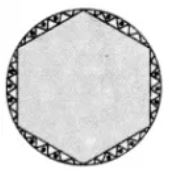
Answer :
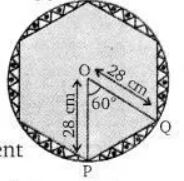
Since, the circle is divided into six equal sectors.
So, sector angle θ = 360°/6 = 60°
Area of the sector with angle 60° and radius 28 cm = (θ/360°) * πr2
= (60°/360°) * (22/7) * 28 * 28
= (1/6) * 22/7 * 28 * 4
= (44 * 28)/3
= 1232/3
= 410.67 cm2 ……………1
Now, area of 1 design = Area of segment APB
= Area of sector – Area of ΔAOB …………..2
In ΔAOB, ∠AOB = 60°, OA = PN = 28 cm
So, ∠OAB = 60° and ∠OBA = 60°
⇒ ΔAOB is an equilateral triangle.
⇒ AB = AO = BO
⇒ AB = 28 cm
⇒ Draw OM ⊥AB
Now, in right ΔAOM, we have
OM/OA = sin 60° = √3/2
⇒ OM = OA * √3/2
⇒ OM = 28 * √3/2
⇒ OM = 14√3 cm
Area of ΔAOB = 1/2 * AB * OM
= 1/2 * 28 * 14√3
= 14 * 14 * 1.7
= 333.3 cm2 ………..3
Now, from (1), (2) and (3), we have:
Area of segment APQ = 410.67 – 333.2
= 77.47 cm2
⇒ Area of 1 design = 77.47 cm2
So, area of the 6 equal designs = 6 * 77.47
= 464.82 cm2
Cost of making the design at the rate of Rs. 0.35 per cm2 = Rs. 0.35 * 464.82
= Rs. 162.68
Question : 14:Tick the correct answer in the following:
Area of a sector of angle p (in degrees) of a circle with radius R is
(A) (p/180) * 2πR (B) (p/180) * πR2 (C) (p/360) * 2πR (D) (p/720) * 2πR2
Answer :
Here, radius (r) = R
Angle of sector (θ) = p
Area of the sector = (θ/360°) * πr2
= (p/360°) * πR2
= (2/2) * (p/360°) * πR2
= (p/720°) * 2πR2
Hence, option (D) is the right answer.

